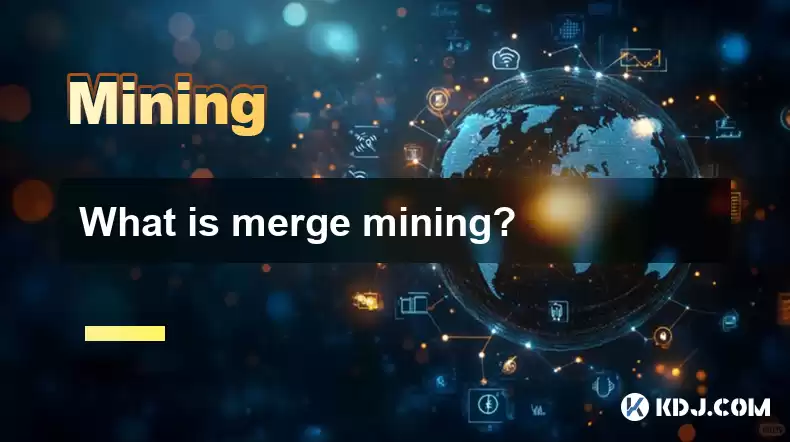-
 bitcoin
bitcoin $124586.364639 USD
0.62% -
 ethereum
ethereum $4670.671710 USD
3.33% -
 xrp
xrp $2.983701 USD
0.18% -
 tether
tether $1.000175 USD
-0.03% -
 bnb
bnb $1209.430642 USD
2.76% -
 solana
solana $231.365861 USD
0.51% -
 usd-coin
usd-coin $0.999665 USD
-0.02% -
 dogecoin
dogecoin $0.264657 USD
4.46% -
 tron
tron $0.346415 USD
1.60% -
 cardano
cardano $0.871586 USD
3.70% -
 chainlink
chainlink $23.451270 USD
7.56% -
 hyperliquid
hyperliquid $46.860071 USD
-2.96% -
 ethena-usde
ethena-usde $1.000120 USD
0.04% -
 sui
sui $3.611279 USD
1.08% -
 stellar
stellar $0.407149 USD
0.96%
What is merge mining?
Merge mining allows miners to mine multiple blockchains simultaneously, boosting security for smaller chains like Namecoin and Dogecoin by leveraging larger networks like Bitcoin and Litecoin.
Apr 08, 2025 at 04:00 pm

Merge mining is a process that allows miners to mine more than one blockchain simultaneously, using the same computational power. This technique is particularly useful for smaller cryptocurrencies that want to leverage the security and hash power of a larger, more established network. By merge mining, these smaller chains can benefit from the same level of security without requiring their own dedicated mining infrastructure.
How Does Merge Mining Work?At its core, merge mining involves a parent blockchain and one or more child blockchains. The parent blockchain is typically a well-established network with significant hash power, such as Bitcoin. The child blockchains are the smaller networks that want to benefit from the parent's security.
In merge mining, miners solve the cryptographic puzzle for the parent blockchain, and in doing so, they can also include a reference to a block on the child blockchain. This reference, known as an auxiliary proof-of-work (AuxPoW), allows the child blockchain to accept the work done on the parent blockchain as valid proof-of-work for its own network.
Benefits of Merge MiningMerge mining offers several advantages for both miners and the child blockchains. For miners, it allows them to increase their potential rewards without needing additional hardware or energy. By mining multiple chains at once, they can earn rewards from both the parent and child blockchains.
For the child blockchains, merge mining provides a significant boost in security. By tapping into the hash power of a larger network, these smaller chains can protect themselves against 51% attacks and other malicious activities. This increased security can also help build trust and attract more users to the child blockchain.
Examples of Merge MiningOne of the most well-known examples of merge mining is the relationship between Bitcoin and Namecoin. Namecoin, a blockchain designed for decentralized domain name registration, uses merge mining with Bitcoin. Miners can mine both Bitcoin and Namecoin simultaneously, using the same hash power.
Another example is the merge mining of Litecoin with Dogecoin. Litecoin, a popular alternative to Bitcoin, has been merge mined with Dogecoin, a cryptocurrency known for its community and meme culture. This relationship allows Dogecoin to benefit from Litecoin's established mining network.
Setting Up Merge MiningTo set up merge mining, miners need to configure their mining software to support multiple blockchains. Here's a step-by-step guide on how to set up merge mining for Bitcoin and Namecoin:
- Choose a Mining Software: Select a mining software that supports merge mining, such as EasyMiner or MultiMiner.
- Download and Install: Download the chosen software and follow the installation instructions.
- Configure Bitcoin Mining: Set up your Bitcoin mining configuration within the software, including your Bitcoin wallet address and mining pool details.
- Add Namecoin Configuration: Add the Namecoin configuration to the software. This typically involves specifying your Namecoin wallet address and the Namecoin mining pool details.
- Enable Merge Mining: Enable the merge mining feature in the software settings. This will allow the software to mine both Bitcoin and Namecoin simultaneously.
- Start Mining: Once everything is configured, start the mining process. The software will now work on solving the cryptographic puzzles for both Bitcoin and Namecoin.
While merge mining offers many benefits, it also comes with some challenges and considerations. One potential issue is the dependency on the parent blockchain. If the parent blockchain experiences a significant drop in hash power or security, it could negatively impact the child blockchains as well.
Another consideration is the potential for centralization. If a small number of miners control a large portion of the hash power on the parent blockchain, they could potentially influence the child blockchains as well. This could lead to concerns about the decentralization and security of the child networks.
Frequently Asked QuestionsQ: Can any blockchain be merge mined with Bitcoin?A: Not all blockchains can be merge mined with Bitcoin. The child blockchain must be compatible with Bitcoin's mining algorithm and support the necessary protocols for merge mining. Additionally, the child blockchain's developers must implement the necessary changes to allow for merge mining.
Q: Does merge mining affect the block reward of the parent blockchain?A: Merge mining does not directly affect the block reward of the parent blockchain. Miners still receive the same block reward for solving the cryptographic puzzle on the parent blockchain. However, they can earn additional rewards from the child blockchains they are merge mining.
Q: Is merge mining legal?A: Merge mining is a legal practice in the cryptocurrency space. It is a recognized method for mining multiple blockchains and is supported by various mining software and protocols. However, miners should always ensure they are complying with local regulations and the rules of the blockchains they are mining.
Q: Can merge mining be used with proof-of-stake blockchains?A: Merge mining is typically associated with proof-of-work blockchains, as it relies on the computational power used to solve cryptographic puzzles. Proof-of-stake blockchains, which use a different consensus mechanism based on staking, do not typically support merge mining. However, some hybrid models that combine elements of proof-of-work and proof-of-stake may explore similar concepts.
Disclaimer:info@kdj.com
The information provided is not trading advice. kdj.com does not assume any responsibility for any investments made based on the information provided in this article. Cryptocurrencies are highly volatile and it is highly recommended that you invest with caution after thorough research!
If you believe that the content used on this website infringes your copyright, please contact us immediately (info@kdj.com) and we will delete it promptly.
- BlockDAG, DOGE, HYPE Sponsorship: Crypto Trends Shaping 2025
- 2025-10-01 00:25:13
- Deutsche Börse and Circle: A StableCoin Adoption Powerhouse in Europe
- 2025-10-01 00:25:13
- BlockDAG's Presale Buzz: Is It the Crypto to Watch in October 2025?
- 2025-10-01 00:30:13
- Bitcoin, Crypto, and IQ: When Genius Meets Digital Gold?
- 2025-10-01 00:30:13
- Stablecoins, American Innovation, and Wallet Tokens: The Next Frontier
- 2025-10-01 00:35:12
- NBU, Coins, and Crypto in Ukraine: A New Yorker's Take
- 2025-10-01 00:45:14
Related knowledge

The difference between staking and mining
Sep 24,2025 at 05:18am
Understanding Staking in the Cryptocurrency Ecosystem1. Staking involves holding funds in a cryptocurrency wallet to support the operations of a block...

How to participate in testnet mining?
Sep 22,2025 at 09:18am
Understanding Testnet Mining in the Crypto Ecosystem1. Testnet mining is a method used by blockchain developers to simulate real-world conditions on a...

How to dispose of abandoned mining machines?
Sep 19,2025 at 08:19pm
Assessing the Condition of Abandoned Mining Rigs1. Begin by inspecting each mining machine for visible damage, corrosion, or missing components. Machi...

How to identify high-quality mining pools?
Sep 21,2025 at 03:19pm
Reputation and Track Record1. A mining pool’s reputation is built over time through consistent performance and transparency. Pools that have operated ...

Advantages of decentralized mining pools
Sep 20,2025 at 04:36pm
Enhanced Security and Resistance to Censorship1. Decentralized mining pools operate on blockchain-based smart contracts, eliminating the need for a ce...

What is mining machine overclocking?
Sep 21,2025 at 07:19pm
Understanding Mining Machine Overclocking1. Mining machine overclocking refers to the process of increasing the operating frequency of a cryptocurrenc...

The difference between staking and mining
Sep 24,2025 at 05:18am
Understanding Staking in the Cryptocurrency Ecosystem1. Staking involves holding funds in a cryptocurrency wallet to support the operations of a block...

How to participate in testnet mining?
Sep 22,2025 at 09:18am
Understanding Testnet Mining in the Crypto Ecosystem1. Testnet mining is a method used by blockchain developers to simulate real-world conditions on a...

How to dispose of abandoned mining machines?
Sep 19,2025 at 08:19pm
Assessing the Condition of Abandoned Mining Rigs1. Begin by inspecting each mining machine for visible damage, corrosion, or missing components. Machi...

How to identify high-quality mining pools?
Sep 21,2025 at 03:19pm
Reputation and Track Record1. A mining pool’s reputation is built over time through consistent performance and transparency. Pools that have operated ...

Advantages of decentralized mining pools
Sep 20,2025 at 04:36pm
Enhanced Security and Resistance to Censorship1. Decentralized mining pools operate on blockchain-based smart contracts, eliminating the need for a ce...

What is mining machine overclocking?
Sep 21,2025 at 07:19pm
Understanding Mining Machine Overclocking1. Mining machine overclocking refers to the process of increasing the operating frequency of a cryptocurrenc...
See all articles










































































